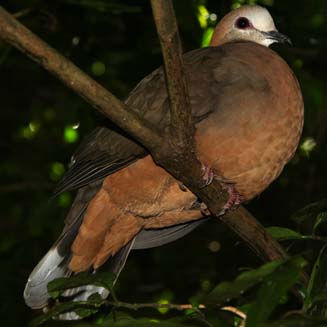|
Aplopelia larvata (Lemon dove,
Cinnamon dove)
Kaneelduifie [Afrikaans]; Indenge, Isagqukhwe [Xhosa];
isAgqukwe [Zulu]; Mhuputi [Shona]; Kaneeltortel [Dutch]; Pigeon à masque blanc
[French]; Zimttaube [German]; Rola-canela [Portuguese]
Life
> Eukaryotes >
Opisthokonta
> Metazoa (animals) >
Bilateria >
Deuterostomia > Chordata >
Craniata > Vertebrata (vertebrates) > Gnathostomata (jawed
vertebrates) > Teleostomi (teleost fish) > Osteichthyes (bony fish) > Class:
Sarcopterygii (lobe-finned
fish) > Stegocephalia (terrestrial
vertebrates) > Tetrapoda
(four-legged vertebrates) > Reptiliomorpha > Amniota >
Reptilia (reptiles) >
Romeriida > Diapsida > Archosauromorpha > Archosauria >
Dinosauria
(dinosaurs) > Saurischia > Theropoda (bipedal predatory dinosaurs) >
Coelurosauria > Maniraptora >Aves
(birds) > Order: Columbiformes > Family: Columbidae
 |
 |
|
Lemon Dove, Kirstenbosch Botanical Gardens, South
Africa. [photos H. Robertson, Iziko
©] |
Lemon Dove. [photo
Jim Scarff
©] |
The Lemon dove is fairly common in near-coastal South Africa,
where it normally lives in leaf litter of indigenous forests. It feeds mainly on
fallen seeds and fruit, as well as small quantities of invertebrates. Both sexes
build the nest, which is a flat platform of twigs and rootlets, usually placed
2.5 metres above ground in a tree or creeper. It lays 1-3 eggs, which are
incubated solely by the female, for 14-18 days.The chicks stay in the nest for
20 days, after which they remain with their parents for 2 months, before
becoming independent.
Distribution and habitat
Occurs in isolated patches of sub-Saharan Africa, including
southern Africa, where it is fairly common in southern and eastern South Africa,
Zimbabwe's eastern highlands and adjacent Mozambique. It generally prefers
leaf-litter filled clearings in
lowland and afromontane forest. In the Western Cape it sometimes moves into pine
(Pinus) and oak (Quercus) plantations.
|
 |
|
Distribution of Lemon dove in southern Africa,
based on statistical smoothing of the records from first SA Bird Atlas
Project (©
Animal Demography unit, University of
Cape Town; smoothing by Birgit Erni and Francesca Little). Colours range
from dark blue (most common) through to yellow (least common).
See here for the latest distribution
from the SABAP2. |
Food
It forages in leaf litter, looking for fallen
seeds and fruit, which account for most of its diet. The following species have
been recorded in its diet:
- Plants
- seeds
- Bamboo
- Podocarpus (Yellowwoods)
- Kiggelaria africana (Wild-peach)
- Calodendrum capense (Cape-chestnut)
- Drypetes gerrardii (Forest ironplum)
- Chrysophyllum viridiflorum (Fluted-milkwood)
- small tubers of unidentified ground orchid
- Invertebrates
-
termites
- small molluscs
- Gullela (Predatory snails)
Breeding
- Both sexes build the nest, which is a flat platform of
twigs and rootlets. It is usually placed 2.5 metres above ground, usually in
the mid-canopy of a tree or creeper
- Egg laying season is from September-December in the Eastern and Western
Cape, but from July-April elsewhere in southern Africa.
- It lays 1-3 eggs, which are incubated by both sexes for about 14-18
days.
- The chicks stay in the nest for about 20 days, after which they
remain with their parents for about two months, at which point they become independent.
Threats
Not threatened, but may be at risk from destruction of
forest.
References
-
Hockey PAR, Dean WRJ and Ryan PG 2005. Roberts
- Birds of southern Africa, VIIth ed. The Trustees of the John Voelcker
Bird Book Fund, Cape Town.
|
